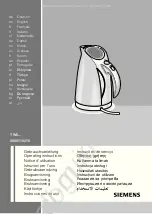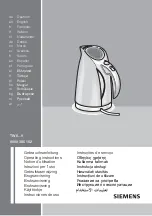
OM-AHS
12
Use sponge, cloth or plastic brush to clean the
kettle.
Scrapers or steel wool can harm the kettle surface.
detergent solution. To make washing easier,
let the detergent solution sit in the kettle and
soak into the residue, or warm the detergent
solution briefly. Do not use any metal
material (like metal sponges) or metal (like a
spoon, scraper, or wire brush) that might
scratch the surface. Scratches make the
surface hard to clean and provide places for
bacteria to grow. Do
not
use steel wool,
which may leave particles imbedded in the
surface and cause eventual corrosion and
pitting.
h. The outside of the unit may be polished with a
recognized stainless steel cleaner like
“Zepper” from Zep Manufacturing Company.
i. When the equipment needs to be sanitized,
use a sanitizing solution equivalent to one that
supplies 200 parts per million chlorine. Obtain
advice on the best sanitizing agent from your
supplier of sanitizing products.
j. Following the supplier’s instructions, apply the
sanitizing agent, after the unit has been
cleaned and drained. Rinse off the sanitizer
thoroughly.
k. It is recommended that the unit be sanitized
just before use.
l. If there is difficulty removing mineral deposits or
a film left by hard water or food residues, clean
the kettle thoroughly. Then use a de-liming
agent, such as Groen De-limer De-Scaler (Part
Number 114800), Lime- Away from ECOLAB or
an equivalent, following manufacturer
directions. Rinse and drain the unit thoroughly
before further use.
m. If especially difficult cleaning problems persist,
contact your cleaning product supplier for
assistance. The supplier has a trained technical
staff with laboratory facilities to serve you.
Maintenance
NOTICE: Contact Groen or an authorized Groen Service Representative when repairs are required.
A Service Log is provided at the rear of this manual.
Each time service is performed on this Groen
equipment, enter the date on which the work was
done, and who did it. Keep this manual with the
equipment.
1. Jacket Vacuum/Removing Air from Jacket
When the kettle is cold, a positive pressure/ vacuum
gauge reading or a reading near zero indicates that
there is air in the jacket. Air in the jacket acts as an
insulator, and slows kettle heating.
a. Start the unit. (Be sure there is water or product
in the kettle when heating).
b. When the pressure/vacuum gauge reaches a
positive pressure reading of five PSI, release
the trapped air and steam by pulling up the
safety valve ring for about five seconds. Repeat
this step three or four times. Then let the pull
ring snap back into the closed position.
c. If there is little discharge (mostly air), and the
pressure gauge drops back to zero PSI, allow
the pressure to build back to five PSI and
repeat the procedure.
To remove air:
Periodic inspection will minimize equipment down
time and increase the effiency of operation. The
following points should be check
e
d:
NOTICE
NEVER LEAVE A CHLORINE SANITIZER IN
CONTACT WITH STAINLESS STEEL SURFACES
LONGER THAN 30 MINUTES. LONGER CONTACT
CAN CAUSE STAINING AND CORROSION.
Содержание AHS-40
Страница 16: ...16 Parts List AHS...








































